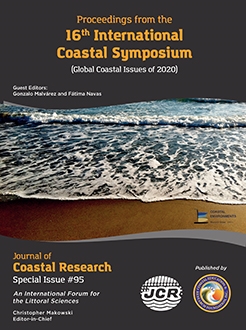Lavaud, L.; Pezerat M.; Coulombier, T.; Bertin, X., and Martins, K., 2020. Hydrodynamics on a rocky shore under moderate-energy wave conditions. In: Malvárez, G. and Navas, F. (eds.), Global Coastal Issues of 2020. Journal of Coastal Research, Special Issue No. 95, pp. 1473-1479. Coconut Creek (Florida), ISSN 0749-0208.
Wave hydrodynamics on rocky shore platforms can be different from that on sandy beaches, namely due to a higher bed roughness. This study investigates short and infragravity waves transformation on a A-type rocky shore platform under moderate-energy wave conditions. Seven pressure sensors and two current meters were deployed along a cross-shore transect topped by a steep sandy beach. Data analysis complemented with a 1D model of energy flux conservation for short and infragravity waves reveals that commonly used value for the bottom drag coefficient has to be multiplied by 20 to match the field observations. Incoming infragravity waves suffer a strong dissipation at low tide due to bottom friction, while a slight shoreward increase is observed at high tide. Further analysis shows that, at this tidal stage, infragravity waves are almost fully reflected.





